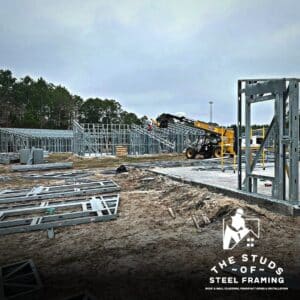The Cost-Effectiveness of Light Gauge Steel Framing in Commercial Construction
In commercial construction, developers are always seeking ways to balance quality, durability, and cost. Light Gauge Steel (LGS) framing offers a cost-effective solution that doesn’t compromise on performance, making it an increasingly popular choice for projects of all sizes. By reducing labor costs, minimizing material waste, and providing long-term savings through reduced maintenance, LGS framing delivers exceptional value. In this post, we’ll explore the various ways LGS framing is a cost-effective option for commercial construction projects.
1. Reduced Labor Costs Due to Faster Construction
One of the key cost-saving benefits of Light Gauge Steel framing is the reduced labor costs associated with its fast and efficient construction process.
- Faster Assembly: LGS components are prefabricated off-site, allowing for quicker assembly on-site. The precision of prefabricated parts ensures that there is less on-site cutting, measuring, or adjusting, which speeds up the construction process.
- Less On-Site Labor: Because the framing is lighter and easier to handle than traditional materials like concrete or heavy steel, fewer workers are needed to install the components. This reduces overall labor costs and shortens the construction timeline, which is particularly important for commercial projects with tight deadlines.
The ability to complete the framing phase more quickly with fewer workers helps developers stay within budget and meet project timelines.
2. Minimal Material Waste with Prefabricated Components
Waste reduction is another significant way that Light Gauge Steel framing helps lower construction costs. Traditional construction methods often result in high levels of material waste, which can drive up costs, but LGS framing minimizes this waste through prefabrication.
- Precision Fabrication: LGS components are cut and manufactured to exact specifications in a factory setting, which reduces the amount of excess material produced. This ensures that less steel is wasted during the construction process compared to wood or other materials that may need to be trimmed on-site.
- Cost Savings from Reduced Waste: Less material waste means lower disposal costs and more efficient use of resources. By reducing the amount of excess material, LGS framing helps developers save money and reduce the environmental impact of the construction project.
By minimizing waste, LGS framing helps control material costs, making it a more budget-friendly option for commercial developers.
3. Long-Term Durability and Lower Maintenance Costs
The long-term durability of Light Gauge Steel framing leads to significant savings over the life of the building, as steel requires far less maintenance and fewer repairs compared to traditional materials like wood.
- Resistance to Pests and Rot: Steel framing is impervious to pests such as termites, which can cause significant damage to wood-framed structures. It is also resistant to moisture, mold, and rot, which reduces the need for costly repairs over time.
- Fire Resistance: Steel’s non-combustible nature reduces the risk of fire damage, further lowering potential repair costs and enhancing the overall safety of the building. This can also result in lower insurance premiums for property owners, adding to the cost savings.
- Minimal Maintenance: Unlike wood, which requires regular treatments for pests, moisture, and fire protection, LGS framing needs little to no maintenance. This reduces the long-term costs of upkeep and extends the life of the building.
By choosing LGS framing, developers and property owners can save money on maintenance and repairs, ensuring that the building remains cost-effective throughout its lifecycle.
4. Lower Insurance Premiums
Because Light Gauge Steel framing is more resistant to fire, pests, and weather-related damage, insurance companies often offer lower premiums for buildings constructed with steel.
- Fire and Pests: Buildings that use fire-resistant, non-combustible materials like steel are seen as lower risk by insurance providers. As a result, property owners can benefit from reduced premiums on fire and property insurance.
- Lower Risk of Structural Damage: The durability of LGS framing also means that insurance companies may offer lower rates due to the reduced risk of structural damage from environmental factors like storms or termites.
These insurance savings can add up over time, further contributing to the cost-effectiveness of LGS framing in commercial construction projects.
5. Energy Efficiency for Long-Term Savings
Light Gauge Steel framing also contributes to energy efficiency, which helps reduce the operational costs of the building over its lifespan.
- Reduced Thermal Bridging: LGS framing minimizes thermal bridging, which helps maintain consistent indoor temperatures. This reduces the workload on HVAC systems and leads to lower energy consumption, particularly in climates like Florida’s, where air conditioning is a significant cost factor.
- Compatibility with High-Performance Insulation: LGS framing supports energy-efficient insulation systems, helping to improve the building’s overall energy performance. By reducing energy usage, property owners can save on utility bills over time.
Energy-efficient buildings framed with LGS help developers and property owners achieve long-term savings, while also contributing to sustainability goals.
6. Versatility in Design Without Added Cost
Light Gauge Steel framing offers developers and architects the flexibility to create innovative designs without adding to the overall cost of the project.
- Customizable for Complex Designs: Steel can be shaped and fabricated to accommodate a wide range of architectural styles, including complex designs that may be more difficult to achieve with traditional materials like wood. This design flexibility is provided without compromising on budget or structural integrity.
- Adaptable for Multi-Story Buildings: LGS framing is particularly well-suited for multi-story commercial buildings, where strength and durability are required. Its high strength-to-weight ratio makes it an ideal material for taller structures, offering cost savings by reducing the need for heavy structural supports.
The versatility of LGS framing ensures that developers can pursue creative, customized designs while still keeping costs under control.
Conclusion: The Cost-Effectiveness of LGS Framing for Commercial Construction
For developers looking to maximize value without sacrificing quality, Light Gauge Steel framing is a cost-effective solution that delivers long-term savings and performance. With its reduced labor costs, minimal material waste, and lower maintenance expenses, LGS framing helps developers stay within budget while providing a durable, energy-efficient structure. Whether for small-scale projects or large commercial developments, LGS framing offers the perfect balance of cost-efficiency and structural integrity.
Contact Elite Steel Today! Interested in reducing costs on your next commercial project with Light Gauge Steel framing? Contact Elite Steel at 1-904-799-6499 or visit elitesteel.com to learn more about how LGS framing can save you time and money while delivering high-quality results.


